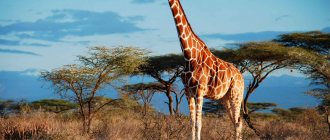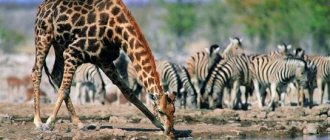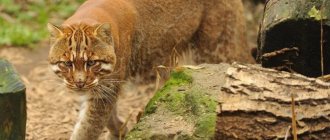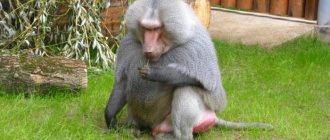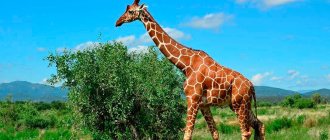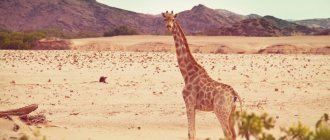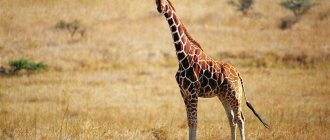The giraffe belongs to the order of ruminant artiodactyls. Its habitat is exclusively in Africa. In Arabic it is pronounced "serafe", which translates as sweetheart. This is one of the most beautiful and unusual living creatures on Earth, the uniqueness of which lies in its growth. Today, the giraffe is the tallest artiodactyl animal in the world. According to observations and research by scientists, the growth of a giraffe ranges from 5-6 meters.
Giraffe - description and appearance
The giraffe is a very unusual representative of the fauna. No other mammal on Earth has a neck of such length. It would seem that it should have a special structure, but no, it has 7 cervical vertebrae, just like any other mammal. The length of each of them is 25 cm. Blood circulates through the neck evenly and with the same pressure, since the animal anatomically has special locking valves. They are located in the main cervical artery.
The closest relative is the forest giraffe - okapi, and the most distant relative is the deer.
An accurate description of a giraffe cannot be without emphasis on its eyes. He has impeccable vision, and his long neck helps him increase his visibility around him. Therefore, he notices approaching danger even at a distance of 2 km. In this case, the animals gather in a large herd in order to jointly defeat the enemy. Males use their hooves to scare away predatory animals.
In addition to excellent vision, the giraffe also has very developed hearing. If they hear any suspicious sound, they can immediately go on the run. At first glance, the giraffe looks quite clumsy, but they can reach good speed, up to 60 km/h. They move in leaps that range up to 5 meters. The mammal can jump over obstacles 1.5 meters high. The giraffe's limbs are quite thin when compared with the overall size of the legs. They move better and more actively on solid soil than in swamps.
On the head, both males and females have a pair of horns. They are covered with wool. The giraffe's eyes are large and pronounced, and they are framed by long eyelashes.
The only place where giraffes live is Africa, and as you know, the air temperature is high there. To survive in this environment, an animal must be able to adapt to the local climate. Giraffes graze exclusively in the morning, until the heat sets in, after which they go to rest in the shade and chew cud. In addition, their skin has a light sand color, which also prevents the animal from overheating.
Communication
Another function that language performs is communicative. For a long time, people were misled by the fact that these animals cannot make sounds at all. Later it turned out that this was not at all the case. In situations where the herd is in danger, they can make trumpet sounds, roar or moo, warning their relatives. This is especially loud in males, whose sounds can be heard far around.
Not long ago, zoologists found that giraffes are capable of not only “voicing”, warning of danger. Their communication skills are much broader, and language plays a major role in this. Studies have shown that they communicate at low frequencies up to 20 Hz, which the human ear cannot detect. The animal can produce these signals due to frequent vibration of the lower part of the tongue. When the muscles contract in the place where it is attached to the larynx, sounds are generated. By this method, animals actively communicate with each other: females are able to calm or call their babies in this way, and males can hint to the female they like that they like her.
Giraffe height and weight
The height of a giraffe on average ranges from 5 to 6 meters, with the neck taking up 30% of it. Weight ranges from 500-1900 kg. It depends on what species the animal belongs to. The appearance of a giraffe creates the impression of an elegant and graceful representative of the fauna. Therefore, it is very difficult to imagine that some individuals can weigh almost 2 tons.
The giraffe is by far the tallest of all living mammals. Scientists say they can reach 7 meters. But the officially recorded tallest giraffe lived at Chester Zoo in England. His height was 6 m.
The animal's heart weighs about 12 kg. This allows you to distill 60 liters of blood per minute.
At birth, the giraffe is about 150 cm tall and weighs 100 kg. An hour after birth, he is already fully on his feet.
Dogs
So many people have a dog as a pet. But few people think about her heart. How big is it?
An amazing fact about dogs is that there is a directly proportional relationship between body size and the heart of a particular four-legged dog. The bigger the dog, the bigger his heart.
Outwardly, it is not much different from human. This organ also has a brownish tint and is located inside the chest. The pulsation of an animal’s heart can reach 70-120 times per minute. Every day this figure can be equated to 144 thousand times at rest. The relationship between heart size and heart rate may seem exaggerated. But the fact remains: regardless of the breed of your pet, after analyzing the proportions and dimensions of his body, you can roughly imagine the size of his heart.
Discreet but tasteful: several pearl manicure ideas for spring
They wanted to clear the roof of snow and almost ended up under it: video
Matcha and seaweed: what the Japanese eat to maintain immunity during Covid-19
Color, tongue size
One of the most interesting parts of the giraffe's body, besides the neck, is the tongue. The first thing you notice is its color: dark, sometimes even almost brown or purple. In addition, the giraffe's tongue is a very strong muscle, which makes it possible to tear branches from trees or their leaves located at great heights. Scientists have recorded that the length of a giraffe's tongue is 40-45 cm. This allows the long-necked animal to clean its own ears and drive annoying insects away from its face.
The animal feeds on any plants, some of which may have thorns, so the tongue has become hard and strong so that it does not suffer from various damage during eating.
Thanks to this unique feature of the structure of the tongue, the giraffe is saved from drought, which can often be observed where the animal lives. All lower leaves and grass are eaten by low-growing animals. Therefore, the giraffe has no choice but to eat leaves from the very tops of the trees, which no one has reached.
Role in the ecosystem
Giraffes are of great importance in the planet's ecosystem. Many species are protected by conservation organizations. Interaction also occurs with other animals and birds. Buff starlings have mutually beneficial relationships with large mammals. They clean the back and neck of giraffes from ticks and insects with their beaks. At the same time, the birds receive the necessary nutrients.
Giraffes are threatened by wild animals and poachers. On land they are hunted by lions, leopards, and hyenas. Near bodies of water during watering hours they are defenseless from attacks by crocodiles. Only large adult individuals are capable of defending themselves; young ones are often attacked. Its impressive size can scare away predators. The hooves of the front legs can deliver heavy blows, which is the self-defense of giraffes. One strong blow can break the skull bone of a not very large animal.
Top articles: 5 tips for buying a dog with minimal stress
https://youtube.com/watch?v=c9IoN4u-UyU
Giraffes are inhabitants of zoos. Proper living conditions benefit animals and prolong their lifespan.
Giraffe color
This mammal has a unique color. The spots on the skin form certain patterns, so it is not always clear what color the giraffe is. Each has its own unique color. It is not repeated among other individuals, but is exclusively individual for each animal. The location, size and color of the spots can be compared to human fingerprints. There are no people in the world with the same fingerprints. Therefore, it is impossible to find two absolutely identical representatives of this species in nature.
Chanel Tapper - Women's Champion
The record holder from the Guinness Book of Records comes from the USA. Its organ reaches 9.75 centimeters in length from the tip of the tongue to the upper lip. Chanel first discovered her originality at the age of 8, during a Halloween photo shoot with her mother. In one photo, both showed their tongues and made funny faces. During a detailed examination of the photograph, Chanel clearly saw that her organ was twice as long as her mother’s. Then Tapper's classmates began to notice this, and she even became popular at school for demonstrating a trick during which she reaches her nose.
The girl admits that today requests to reach her elbow or nose are familiar to her, she has long gotten used to popularity, but she never ceases to show the uniqueness of the organ. The student did not immediately decide to submit an application to the Guinness Book of Records. She wondered if she needed to be so popular, to show off her tongue to the whole world. After thinking carefully, I finally decided that I would really like to become famous. Measurements were taken, after which the girl was officially recognized as the owner of the world's largest, longest tongue among a female representative. If you stick it out to its full length, the organ appears even below the chin. The student understands that maybe her achievement does not seem very pleasant or understandable to someone, but she herself has no problems with it. After all, the girl was born this way, so she is not shy about this uniqueness.
How do giraffes sleep?
Many people are interested in the question: “How and how much does a giraffe sleep?” Everything is very simple. He curls up and rests his head on his rump. The height of the giraffe does not allow this to be done quickly. To assume this position, the mammal must first bend its legs. One limb must be moved to the side. After which he takes a comfortable position. In addition, giraffes also sleep in a standing position. The long-necked one sleeps short. Usually about 10 minutes is enough for him to sleep. At the same time, a giraffe sleeps no more than 2 hours per day. Even at night he constantly gets up to drink some water or have something to eat.
Types of giraffes
The giraffe family includes 1 species. There were 5 more, but they are all already extinct. The animal with the longest neck is classified according to its habitat and the type of pattern on its skin. Today, the following subspecies of giraffes are distinguished:
- Nubian. It is found in eastern Sudan and western Ethiopia. The color contains chestnut spots, which are outlined by white lines.
- Ugandan. His second name is Rothschild. Uganda became his habitat. It is famous for its brown spots, which are separated by white stripes. They have a fairly large shape.
- Reticulate. Also called Somali. It can be found on the northern side of Kenya and southern Somalia. Their color is distinguished by rich spots of brown-red hue, which are framed by thin white lines. They are medium in size and have sharp edges.
- Angolan. Lives in Namibia and Botswana. The color is distinguished by brown spots, which are quite large and noticeable from afar. Moreover, they have elongated corners.
- Kordofan. Its habitats are considered to be western Sudan and the Central African Republic. This mammal's spots on its body are unevenly distributed.
- Maasai. Lives in southern Kenya and Tanzania. The spots vaguely resemble a star in shape and are most concentrated in the leg area.
- South African. Found in Zimbabwe, South Africa and Mozambique. The giraffe has a golden skin, decorated with round spots of dark color.
- Thorneycroft. Lives in Zambia and is distinguished by its light skin with spots with sharp edges that have dark shades.
- West African. This species has practically disappeared from the face of the Earth. According to data for 2007, there were 175 individuals in the world. Its natural habitat is Chad.
Natural enemies
The size of the giraffe prevents most predators from causing any harm to it. As a defense, the giant uses its front hooves, the blow of which can break the skull of any predator, regardless of its speed and strength. It is precisely because of this terrifying power that adults are not attacked - they are simply feared. But hyenas, leopards and lions can target young animals that are not difficult to kill, which is why only 25-50% survive to adulthood.
The most protected and strongest place in the body of this animal can be safely called the neck, the muscles of which can withstand enormous loads and a third of the weight of the entire giraffe. Therefore, predators try to attack thin legs, breaking which the animal will no longer be able to stand up and give any resistance, because it is the front hooves that are the main means of defense against attacks.
But sometimes there are exceptions, for example, an incident in a nature reserve in northern Namibia, which was reported by eyewitnesses: lions jumped on a giant and bit his neck, causing him to fall lifeless.
Much worse for giraffes are insects like fleas, which are always trying to settle on the giant’s body. The animal’s long tail helps it brush them off, and if that doesn’t help, then birds come to the rescue: starlings and other birds will clean the skin without any problems, but they can cause infection, so people watch everything closely.
Giraffe habitat
Giraffes live in the wild in Africa. This is the only continent where they can be found in their natural habitat. Herds of giraffes or individual individuals are found in the southern and southeastern regions of the Sahara Desert. In addition, they began to live in even more arid areas of African land where people do not live. Thanks to their bodies and low water consumption, these mammals exist comfortably in the open forests of Africa.
Previously, long-necked animals were subject to total hunting, so they had to change their usual habitats. Today they are found in places where they were not previously found.
Lifestyle
Giraffes are considered diurnal inhabitants. They eat food in the early morning and also in the afternoon. Their hottest hours are spent in a state of half-sleep somewhere in the shade of trees. At these moments they have gum in their mouth, which they like to chew, their eyes are slightly closed, but their ears are always alert. The main sleep takes place at night, during which they lie down in a specific position from which they can quickly get to their feet.
Basically, these mammals are united in groups, the number of which does not exceed 20-25 individuals. Their composition is not constant; animals can join and come to them at will. A special connection can be seen between babies and females: they try to protect weaker and not yet independent children, risking their own lives. When they are in open areas, they try to gather in crowds, and when they eat, they disperse in all directions.
Adults are actively looking for a female, but they come across dominants who do not provide a normal life for animals desiring attention. It is because of the strong representatives of the species that duels often occur within groups.
In dry weather and at its height, when there is less food, the groups are divided into small groups of 5 individuals to make it easier for them to feed themselves, and in the rainy season they unite again, since there is enough food.
Giraffes can graze for 12 hours a day, mainly during sunset or dawn, when the sun's rays are not so intense. You can often hear them called "pluckers" - this name comes from their method of obtaining food. They literally pinch flowers, foliage, young shrubs and trees with their tongues, feeding at a height of two to seven meters. They can bend over for grass only because of the young shoots that sprout during the heavy rainy season. Wherever the animal lives, it will still give preference to its favorite delicacy - acacias. The giants only add other types of plants to their menu for the second time in order to replenish their water or vitamin reserves. In severe drought, they can feed on cacti and fallen leaves.
They have long hairs on their lips, from which a signal is sent to the brain, indicating the degree of maturity of the leaves and the presence of some toxic substances in them. The tongue is strong, mobile, reaches 50 cm in length and can slip among the spines. By pulling branches with the largest amount of food to its upper lip, the papillae on the edges of the lips allow it to hold the desired plant in its mouth, which the giraffe subsequently cuts off using its lower jaw. The giant stretches the smoother branches deeper, where there is free space, and then tears off all the leaves without harming the bark.
A feature of all ruminants is the repeated chewing of any food, due to which the food is absorbed several times faster. Giraffes have a unique ability: they can chew food even while moving, which means their grazing time increases significantly.
Compared to their height and weight, males of this family need 50-60 kg of greens per day, and females need even less - up to 45.
Giraffes' food has a huge amount of useful substances and consists of more than 50% water, so they almost never have to additionally replenish their water balance, but they still sometimes like to drink clean water. In rare cases, they also have to eat the soil due to the lack of the necessary mineral salts in their body, but there is plenty of them in the soil.
For a long time, people believed that this species of mammals did not have a voice, but they were wrong. Scientists have proven that they have a normal vocal apparatus, allowing them to produce a huge range of sounds. In case of danger, they can cry out, releasing air through their nostrils; in a fight or when excited, the males cough or growl. It may even be that at the peak of orgasm they may roar. The cubs, frightened, begin to scream pitifully without opening their mouths, thereby calling older males or females to them, who will aloofly save their child.
Giraffe nutrition
The giraffe has a four-chambered stomach, so many people are curious about what a giraffe eats. He is completely dedicated to eating plant-based foods. The animal chews leaves and tree branches using its ruminant jaw. This is done very carefully and slowly. Giraffes regurgitate leftover food from the first chamber of the stomach in order to chew it again. This process is called chewing cud.
Africa has a very arid climate, so not everyone knows what giraffes eat to survive in these difficult conditions. But in the course of evolution they adapted to such conditions.
The height of a giraffe will always help it find food. The animal primarily feeds on succulent acacia. Mimosa or wild apricot shoots can replace it. The food that a giraffe eats can weigh up to 30 kg per day, so it spends 16 to 20 hours a day obtaining and chewing it. If the leaves eaten are juicy enough, the animal can be without water for a long time.
In order to drink, the giraffe must spread its legs wide enough and tilt its head towards the pond. In one such approach, he can drink 38 liters of liquid.
If a long-necked animal lives in a zoo or nature reserve, then its menu there is somewhat more varied than in the wild. The diet consists of leaves, grass, in particular clover, hay, and some vegetables and fruits are also added, such as bananas, oranges or carrots. In addition, the long-necked mammal likes to feast on bread. Workers always take care of their pets, and to make the spotted long-necked animal more comfortable, all food and water are raised to the level of their heads.
Small giraffes feed on mother's milk after birth and up to 4 months. After this period, the baby needs to be taught to eat on his own.
Octopuses
Have you ever heard of an animal with three hearts? If not, then we will tell you a secret - the octopus is such an animal. Of the three hearts, two are designed to pump blood to the gills, and the third takes care of the functionality of the marine organism as a whole.
The octopus spends more time crawling underground. This is because while swimming, all three of its hearts are subject to increased stress, causing the mollusk to quickly become exhausted. Therefore, he prefers the comfortable seabed zone and coral reefs.
Giraffe breeding
In their natural habitat, giraffes most often live alone or group in a small herd. Antelopes or zebras become their neighbors. Interesting facts about giraffes say that they are polygamous. The male protects his females from all outside contenders for their hearts. At the same time, the male does not mind mating with new females that come into his field of vision.
A favorable period for having offspring is the rainy season. On the African continent it lasts from July to September. The gestation period is about 14-15 months. If conception occurred on time, then its birth will occur just during the dry period, which will give the little giraffe the opportunity to stand firmly on its feet. The female gives birth standing. Therefore, the cub has to fall from a height of almost two meters. Scientists were able to record how much a giraffe weighs immediately after birth. The weight of a newborn is approximately 100 kg. The height of a giraffe at birth is 150 cm.
The marriage games are very beautiful and theatrical. First, the male must carefully sniff the female’s fresh urine and judge from her smell whether she is ready for the mating process. After this, he begins to rub his head against the sacrum. After which he carefully places his head on the female’s back. If she accepts these advances, she moves her tail to the side. That is, it allows the male to approach.
A baby giraffe is born without horns. In their place, he grows black hair. Underneath it is cartilage. As the giraffe grows, it ossifies, after which it transforms into small horns. Hair also disappears as we grow older.
Miramid wasps
Fairyflies are tiny species from tropical regions that are considered the smallest flying insects. They have a fairly short lifespan and are able to stay underwater for 15 days. But the most interesting thing is that there is a heart in the body of these miniature insects. It, of course, differs from the human one - there is no heart muscle, and the main transportation of blood to the head is carried out through a narrow tube located along the back of the insect. That is, in fact, the heart of the miramid wasp ensures blood circulation in an open system, without the presence of arteries and veins. But an unusual nuance is that the heart of such a wasp, with a size of 0.13-0.55 mm, is considered the tiniest in the whole world.
Peach coloring: 10 ideas for creating an incredibly delicate look
Woven moccasins and 4 more pairs of flats to keep your feet from getting tired
The Italian flew to Russia specifically to play a popular song (video)
To examine the main vital organ of amazing wasps, scientists use microscopes. The individuals themselves are awarded by nature with a black, brownish or yellow color, and the H-shaped patterns present on their heads clearly distinguish them from other insects. Because this species of wasp is difficult to get to, little is known about them until now. But the fact that miramid wasps have the smallest hearts in the world is undeniable at this stage of the research.
Life expectancy of giraffes
How many years does a giraffe live? Of course, such a large animal should live a very long time, but the average age is 20-23 years. The maximum age a giraffe lived was 28 years. The cub is with its mother from the moment of birth until 1.5 years of age. At 4 years old it becomes sexually mature.
In captivity, life expectancy increases and can reach about 30-35 years.
